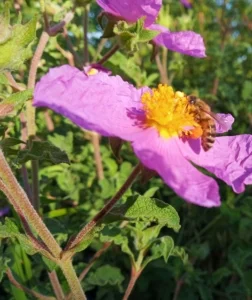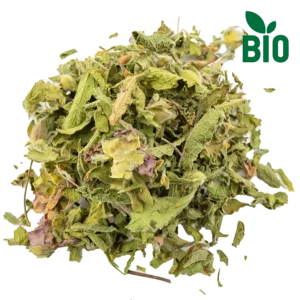In the wonderful world of Mediterranean plants, cistus, also known as pink rockrose, is one of the most enchanting plants of the Cretan biodiversity. With its latin name Cistus creticus, this aromatic plant hides a rich history and tradition. Today this herb combines ancient mythologies with its modern uses. In this article, we will explore some of the secrets of cistus, revealing why this plant retains such an important position in Greek natural heritage and tradition.
«Cistus, with its aromatic flowers, is the soul of Cretan nature and its tradition. A plant that connects centuries of history with modern culture, bringing the beauty of the Mediterranean to each of us.»

Cistus (Cistus creticus), also known as pink rockrose, is an important part of our island. Its presence on the island goes back centuries, dating from ancient times. There it was a common plant in the Cretan flora. Known for its fragrant flowers and its durability, kistos is associated with Cretan culture and tradition.
The ancient Cretans valued the plant for its medicinal benefits and used it to make aromatic oils. At the same time, the flowers of cistus had symbolic significance in various ceremonies and etiquette practices, reflecting the integration of nature into the daily life and traditions of the Cretans.
Over the centuries, the aladania has continued to hold an important position in Cretan society. In traditional Cretan medicine, healers used the plant to treat a range of health problems, from digestive disorders to skin diseases, taking advantage of its anti-inflammatory and antimicrobial properties.
Today, cistus is still a symbol of Cretan nature and heritage. It is also a valuable resource for the local community. From folk tales to modern research, cistus continues to enchant with its history, its aromas and its diverse uses.
In the village of Sises in Crete, one of the most interesting and traditional activities is the harvesting of resin from cistus. This process, which requires great skill and knowledge, is one of the most authentic forms of connection with nature and the tradition of the village.

Using homemade tools, usually made by the residents themselves, the collectors approach cistus plants with great care. The process is designed to remove the resin from the leaves of the plant without damaging the bush. The resin, with its strong aroma and healing properties, is a valuable natural resource.
Picking resin is not only a task but also a ritual. It is a genuine expression of a connection with nature and tradition. The inhabitants of Sises, connoisseurs of this art, pass on their knowledge and skills from generation to generation. In this way they keep alive a tradition that is closely linked to the identity of the village and the region of Rethymnon.
The use of cistus (Cistus creticus) as a medicinal plant has deep roots in the history of Crete. Since biblical times, people have used its resin for therapeutic purposes. The ancient Greek Dioscorides mentioned this in his work ‘De materia medica’. The plant has served various uses, including as a diuretic, a treatment for toothaches, an analgesic, and a soothing cough suppressant. Modern scientific studies have focused on the plant’s antibacterial, antifungal, antiviral and anti-inflammatory properties. Also of particular interest is its activity against West Nile virus and Lyme disease.
More about the therapeutic properties of cistus, also known as pink rockrose, can be found here.
Sustainable harvesting and cultivation of Cistus focuses on the conservation of natural populations and the protection of biodiversity. The use of sustainable agricultural practices and the encouragement of cultivation of the plant in a way that respects the natural environment contribute to the protection of the cistus as a species. Such practices ensure that the plant is used in a sustainable way, providing its benefits to future generations. The addition of organic cistus to our tofillo range of organic products was an early decision as the area of our estates had been the location of a devastating fire.
In modern times, people widely use the pink buttercup (Cistus creticus) in cuisine and cosmetology. Chefs often add the plant to herbal tea blends and recipes featuring fish, chicken, or pasta, enhancing the flavor uniquely. In cosmetology, various products incorporate Cistus creticus extracts, primarily for skincare, leveraging the plant’s antioxidant, antimicrobial, and anti-inflammatory properties.

We collect people’s stories about cistus, recording their experiences and the unique uses of the plant in their lives. An experience recorded several years ago in the village of Sises. Residents who worked at collecting resin from cistus in the summertime did not get sick during the winter. During the summer in Crete, high temperatures contribute to the evaporation of the essential oils of the olive tree. During this collection of resin, thus perfuming the atmosphere they were forced to inhale it. This natural way has proven beneficial to the health of the inhabitants, revealing one of nature’s secrets.
In closing our article on cistus, we highlight the enchanting beauty and rich tradition of this Mediterranean shrub. From its ancient roots in Crete to its modern uses in cuisine and cosmetology, cistus continues to inspire and impress. Cistus is not just a plant; it is a symbol of life, tradition and harmony with nature, keeping an ancient heritage alive and promising to continue to enrich our lives for generations to come.
FAQs
The Cretan cistus (Cistus creticus) is a Mediterranean aromatic plant, famous worldwide for its powerful antioxidant properties. The aladania, especially from Crete, is known for its excellent properties, as the conditions of the island favour the growth of a plant rich in active ingredients.
Natural populations of the Cistus creticus are found mainly in the Mediterranean, with a particular focus on the islands and the rural area of Crete.
Cistus is used in folk medicine for its antioxidant properties, antimicrobial and anti-inflammatory action. It also has a soothing effect on skin problems, in the relief of digestive disorders and the treatment of respiratory infections.
Cistus or pink rockrose offers multiple benefits, which are discussed in detail in our article on the subject.
All herbs are nature’s medicines. So as medicines they also have side effects. Pregnant and lactating women should pay special attention and consult the experts in case of any health problem.
More details about Cistus, presented in our article «Cistus creticus: The legendary Cretan herb».”
Subscribe to our newsletter to stay informed about herbs, recipes, exclusive offers, and receive a 15% discount on your first order!

Ευχαριστούμε πολύ τα παρακάτω websites για τη συνδρομή τους σε επιπρόσθετο, ελεύθερο φωτογραφικό υλικό (free stock) που χρησιμοποιείται στην ιστοσελίδα μας:
Pixabay.com
Pexels.com
Unsplash.com
Freepik.com
Canva.com
Adobe.com
Σταύρος Δεβεράκης (Φωτογράφος)
Many thanks to the following websites for their subscription to additional, free stock photography used on our website:
Pixabay.com
Pexels.com
Unsplash.com
Freepik.com
Canva.com
Adobe.com
Stavros Deverakis (Photographer)